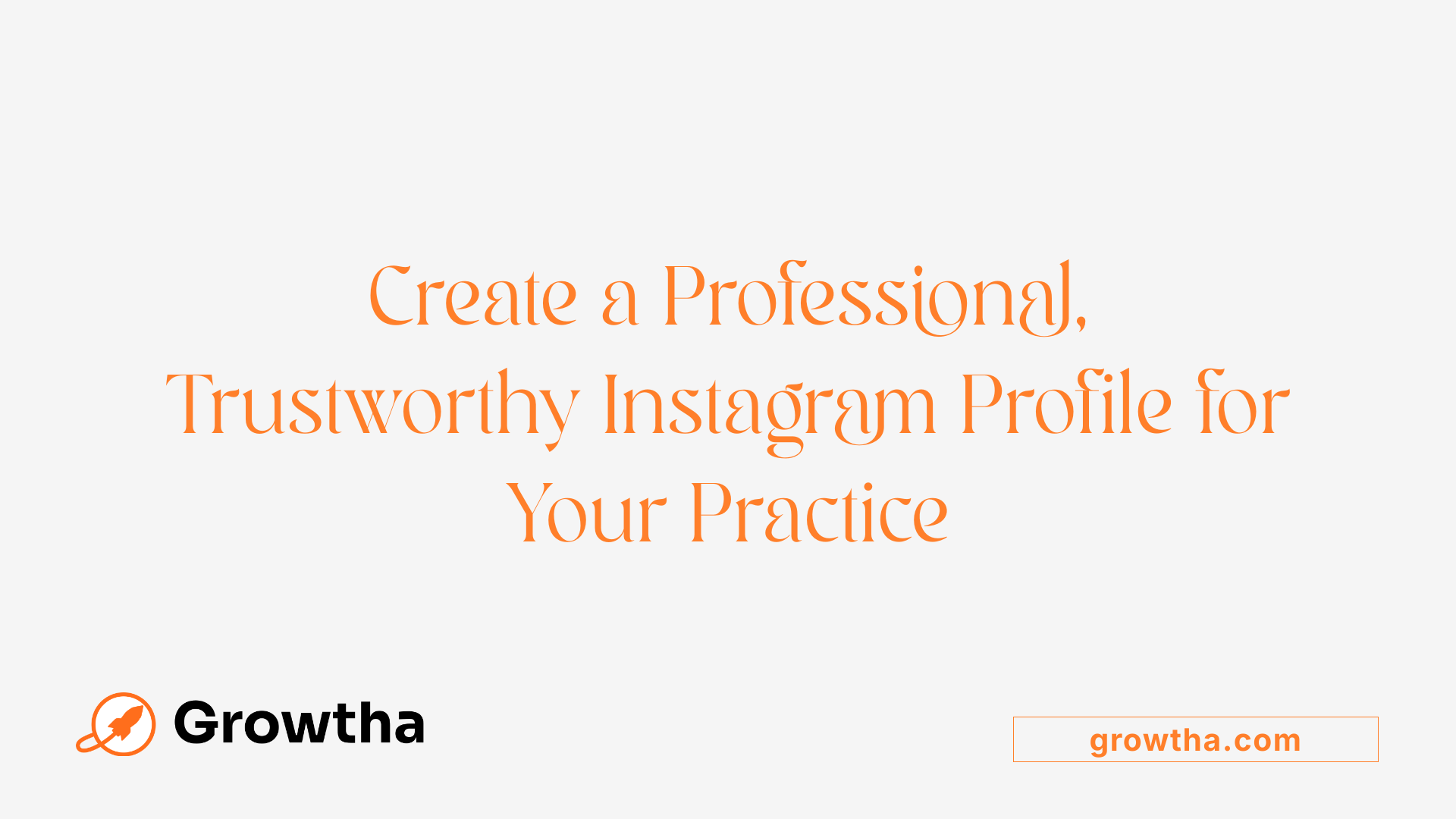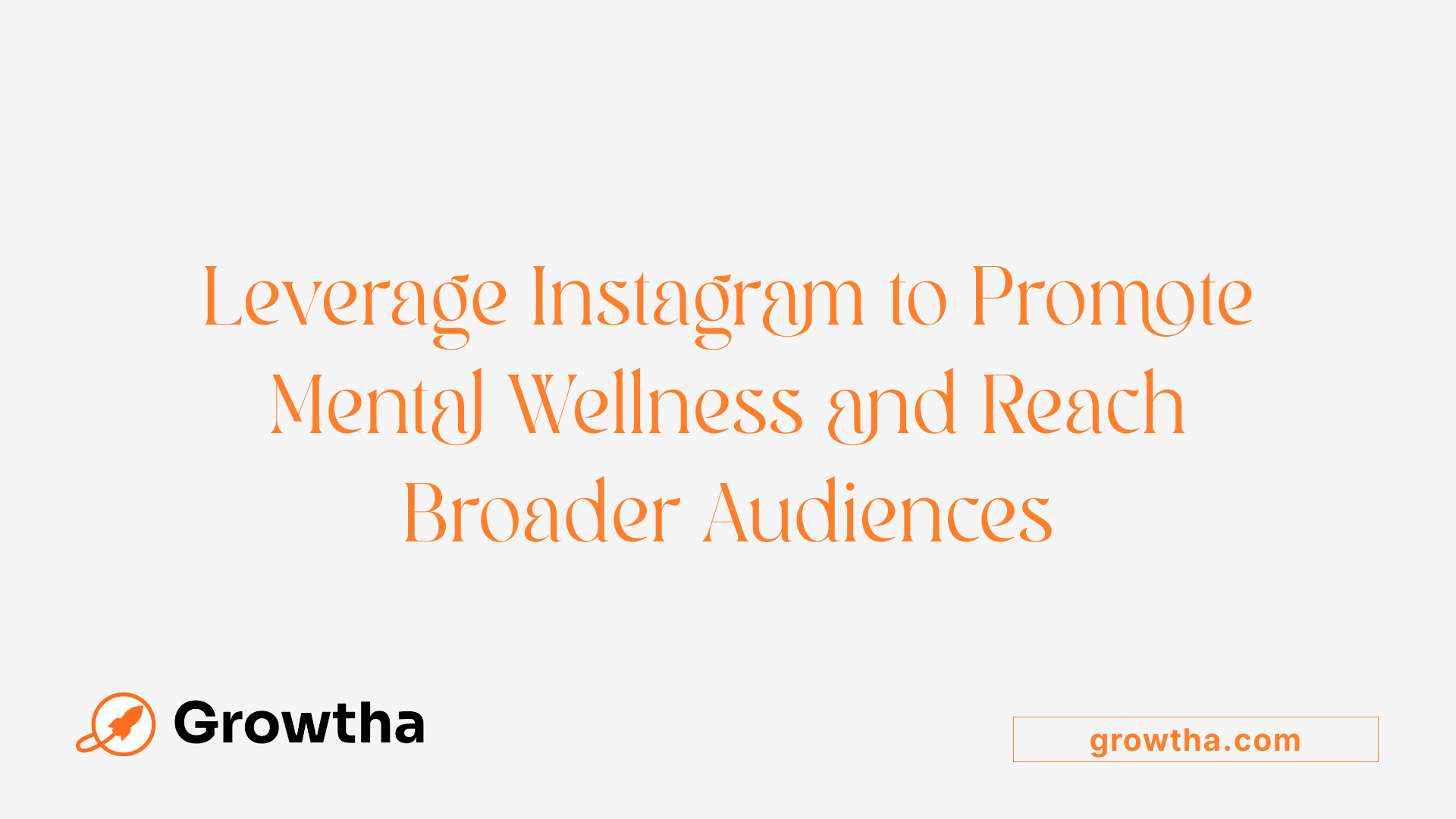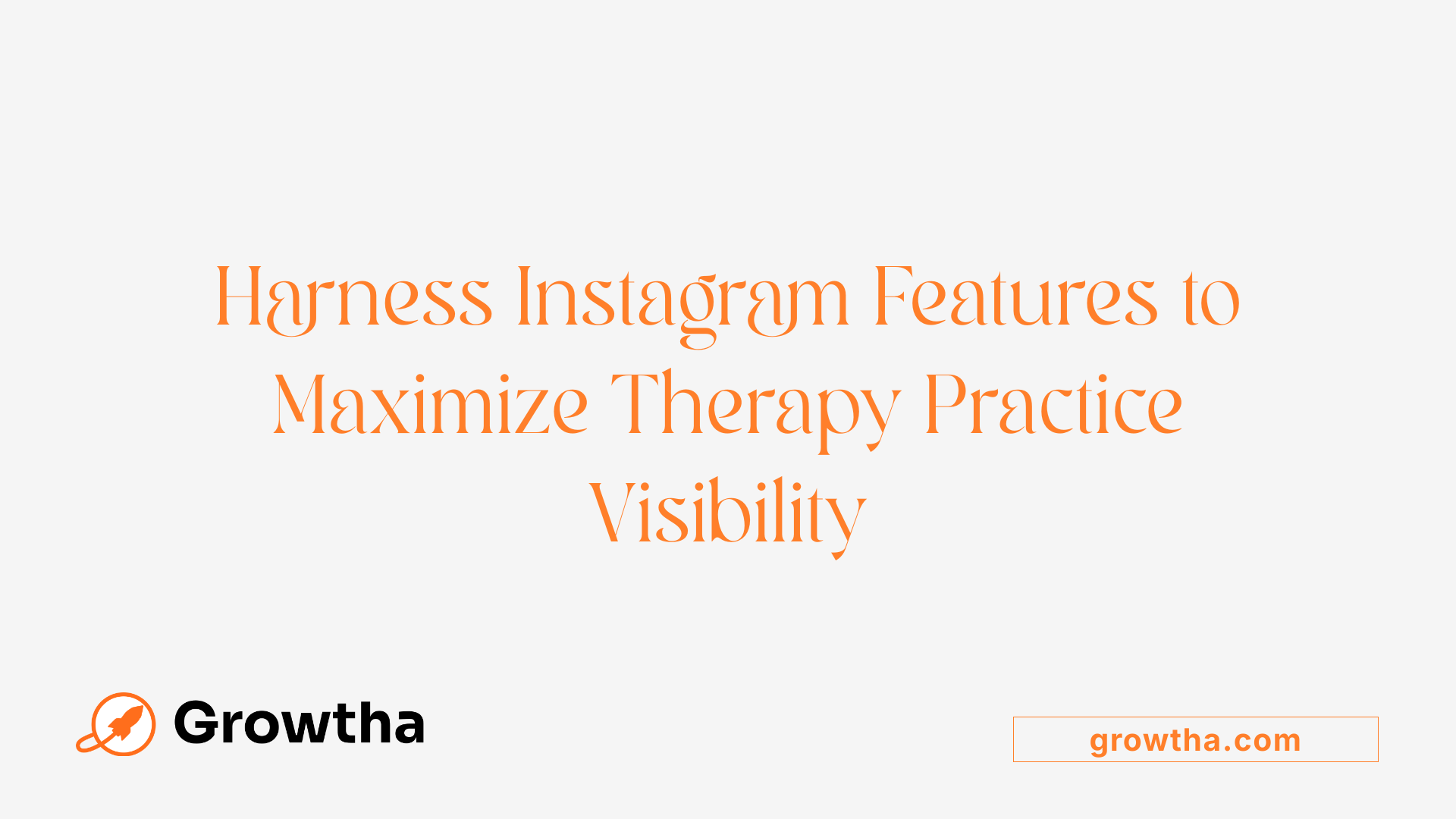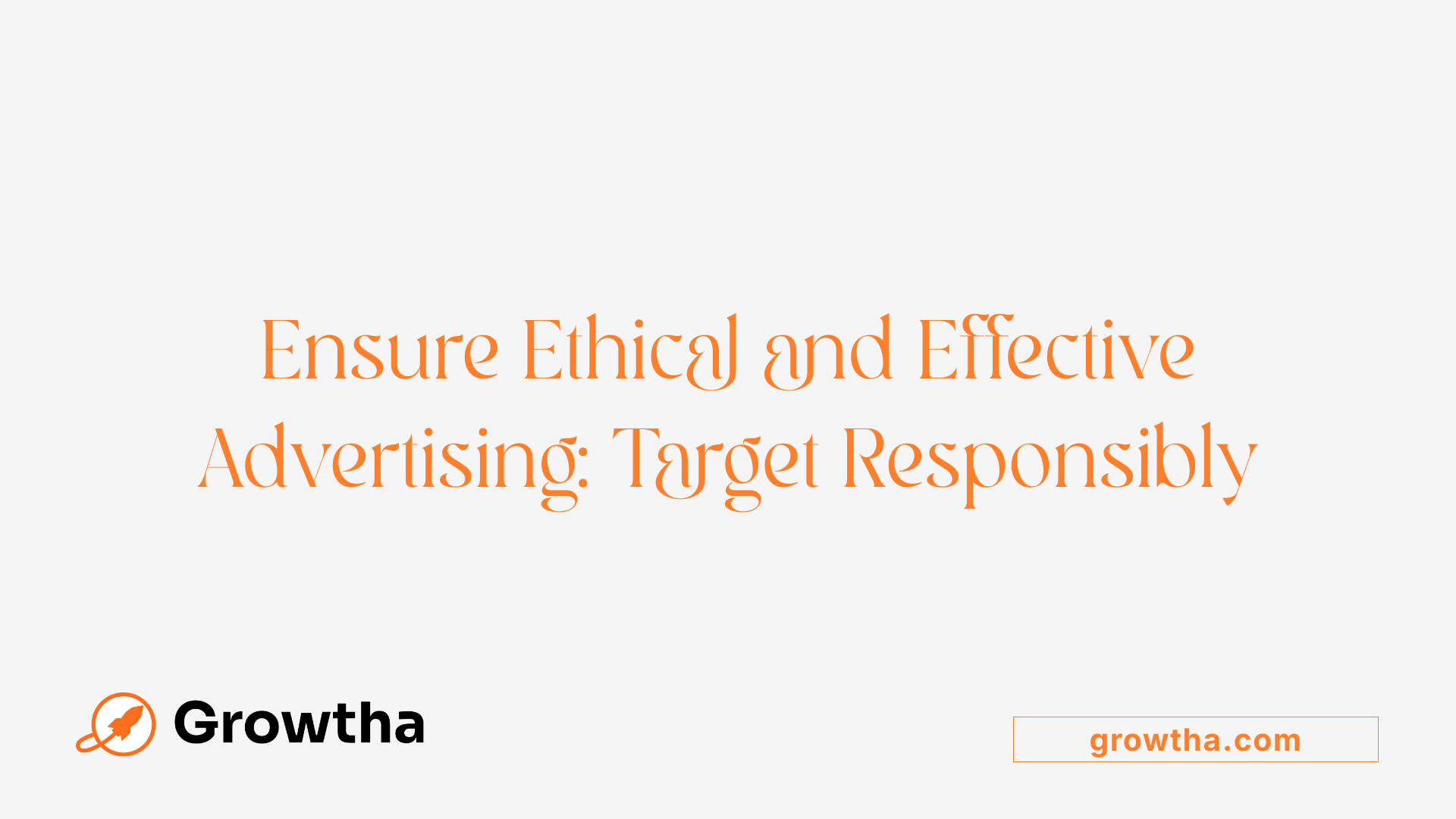How to Use Instagram Ads for Therapy Services
Maximizing Reach: Effective Instagram Advertising Strategies for Therapists


How to Use Instagram Ads for Therapy Services
Harnessing Instagram to Grow Your Therapy Practice
In the competitive landscape of mental health services, establishing a strong online presence is crucial. Instagram, with over a billion active users, offers a powerful platform for therapists to connect with potential clients, build trust, and promote their services ethically and effectively. This guide explores how therapy practices can leverage Instagram ads to attract new clients, increase awareness, and grow sustainably.
Setting Up a Professional Instagram Profile for Therapy Practices

Creating a business account on Instagram
Starting with a business account on Instagram offers therapy practices access to powerful tools such as Instagram Insights, messaging inboxes, and contact features. These features are essential for managing client interactions, analyzing engagement metrics, and optimizing content strategies. Establishing a business profile also enables the practice to run targeted ads, showcase services, and appear more professional to potential clients.
Optimizing profile with clear bio, contact info, and profile picture
An effective therapy practice profile begins with a well-crafted bio that clearly states your specialization, approach, and what clients can expect. Including your contact information, such as phone number and email, makes it easy for prospective clients to reach out. Use a professional, high-quality profile picture—often a headshot or logo—that reflects your brand identity. Consistency in visual branding throughout your profile helps establish trust and recognition.
Organizing Highlights for easy access to services, testimonials, and tips
Instagram Highlights serve as an accessible, permanent collection of your best stories. Organize highlights into categories like 'Services', 'Client Testimonials', 'Self-Care Tips', and 'FAQs' to provide visitors with quick insights into your practice. Well-organized highlights create a user-friendly profile, encouraging new visitors to learn more about your offerings and establishing your practice as approachable and credible.
| Aspect | Best Practice | Why It Matters |
|---|---|---|
| Profile Picture | Clear, professional image or logo | Builds recognition and trust |
| Bio Content | Concise description + contact info | Communicates your niche and makes contact simple |
| Highlights | Organized categories | Enhances user experience and accessibility |
| Posting Schedule | Regular, consistent posting times | Increases engagement and visibility |
What is the typical cost of advertising on Instagram for therapy practices?
Advertising costs on Instagram vary based on several factors like campaign objectives, the target audience, and bidding strategies. Generally, the cost per thousand impressions (CPM) for therapy practices ranges from $2.50 to $3.50, but recent data from June 2025 shows an average CPM of about $8.16. Engagement-based campaigns often cost between $0.01 and $0.05 per engagement, while the cost per click (CPC) usually stays between $0.40 and $0.70.
For ad formats like Reels, costs tend to be lower, averaging around $4.29 in early 2025, making them an economical choice for engaging content. Practitioners should consider these costs when planning their advertising budget, aiming for around $3 to $8 per thousand impressions and less than a dollar per click on average. Effective targeting and optimized ad content are crucial to maximize ROI.
Is a daily budget of $5 sufficient for Instagram advertising campaigns for therapy services?
A daily budget of $5 for Instagram ads is typically insufficient for meaningful results in this context. Given that the average CPC ranges from $0.20 to $2, and higher depending on targeting specifics, such a limited budget might only yield minimal exposure. While small tests can be conducted with $5 per day, they rarely generate substantial engagement or lead to new patient inquiries.
For more impactful campaigns, a monthly budget closer to $100 for retargeting efforts or about $300 for attracting new clients via Google Ads is recommended. Aligning your ad spend with your overall marketing goals—such as increasing new client inquiries or boosting awareness—is essential. Increasing your daily budget beyond $5 enhances the potential reach and effectiveness, helping to achieve your practice’s growth objectives.
How to leverage Instagram features and create effective content
Therapists should utilize the full spectrum of Instagram features: posts, Stories, Reels, IGTV, and Highlights—to keep their audience engaged. Diverse content types—educational posts, client testimonials (with permission), inspirational quotes, behind-the-scenes glimpses, and therapeutic tips—are all helpful in establishing authority and authenticity.
Using Stories for quick updates and engaging Q&As keeps followers involved, while Reels provide short, dynamic content that can reach broader audiences. Collaborating with other professionals or influencers can amplify your reach and credibility.
Tips for successful Instagram marketing for therapy practices
- Build a authentic personal or practice brand.
- Use relevant hashtags thoughtfully to increase discoverability.
- Engage actively with followers through comments, DMs, and polls.
- Share credible, evidence-based information.
- Maintain visual and messaging consistency.
- Avoid superficial engagement; focus on meaningful interactions.
- Share a mix of personal and professional content using the 80:20 rule.
- Use scheduling tools like Hootsuite or Buffer to plan and maintain posting consistency.
Effective use of Instagram as part of a broader marketing strategy can help therapists demystify mental health topics, reduce stigma, and directly connect with potential clients.
In conclusion, setting up an optimized, professional Instagram profile is a foundational step for therapy practices aiming to enhance online visibility and client engagement. By strategically utilizing the platform’s features and managing advertising budgets wisely—typically in the range of a few dollars daily for ads—therapists can grow their practice efficiently while maintaining ethical standards.
Understanding the Power of Instagram for Mental Health Promotion

Why is Instagram a valuable marketing tool for therapists?
Instagram offers an expansive, highly visual platform that can be used effectively to connect with current and potential clients. With over 1 billion active monthly users and 500 million daily users, it provides broad reach. Therapists can humanize their practice by sharing personal stories, behind-the-scenes glimpses, and mental health tips that foster genuine connections. Utilizing features like stories, reels, IGTV, and highlights allows for diverse content delivery that keeps the audience engaged.
Creating a professional business account is essential, as it unlocks access to valuable tools such as Instagram Insights, messaging inboxes, and contact options. These features help therapists track engagement trends, visitor activity, and website clicks, informing ongoing marketing strategy adjustments. With a well-maintained profile, including a clear bio, a professional headshot, and organized highlights, therapists communicate professionalism and approachability.
Key demographics and user behaviors
Understanding who uses Instagram helps therapists craft relevant content. The platform's demographics tend to include younger adults, but its broad user base encompasses diverse age groups, locations, and interests. To reach the right audience, therapists should define their target market through surveys of existing clients and research on Instagram’s user base. Refining demographics, psychographics, and geographic targeting ensures marketing efforts go to those most likely to seek therapy services.
Data from Sprout Social suggests optimal posting times are Tuesdays from 11 a.m. to 2 p.m., with other weekday mornings around 11 a.m. also performing well. Posting consistently during these peak times maximizes visibility. Engaging with followers through comments, direct messages, and interactive features like polls and Q&As builds trust and community.
Reach potential clients through authentic, relatable content
Authenticity is crucial on Instagram. Patients are drawn to genuine, relatable content that reflects the therapist’s personality and values. Sharing educational posts, inspirational quotes, client testimonials (with permission), and behind-the-scenes content helps humanize the practice. Creating diverse content buckets — including awareness, education, self-care, myth busting, and book recommendations — keeps the feed engaging.
Using relevant hashtags increases discoverability, while collaborations with other mental health professionals and influencers expand reach. Consistent posting, strategic use of content formats like reels for quick tips, stories for real-time updates, and carousel posts for in-depth topics, all contribute to building a trustworthy online presence.
นำอัตรา engagement ด้วยการสร้างคุณค่าในเนื้อหา การมีปฏิสัมพันธ์อย่างจริงใจและความสม่ำเสมอ ทำให้ผู้ติดตามรู้สึกเชื่อมโยงและไว้วางใจในบริการของคุณมากขึ้น
| Aspect | Strategy | Details |
|---|---|---|
| Content Types | Stories, Reels, Posts, Highlights | Use a mix to diversify engagement and showcase different facets of therapy practice |
| Posting Times | Tuesdays 11 a.m. - 2 p.m., weekdays around 11 a.m. | Optimize timing based on data to reach maximum audience |
| Content Buckets | Awareness, education, inspiration, behind-the-scenes, myth busting, books | Keeps content fresh and relevant |
| Engagement Tactics | Comments, DMs, polls | Builds community and trust |
| Collaboration | Fellow professionals, influencers | Enhances credibility and reach |
How can therapists leverage Instagram to market their services effectively?
Therapists should start by creating a business account to gain access to analytics, contact options, and messaging features. Defining their target audience involves surveying current clients and researching demographics who use Instagram. This helps in tailoring content that resonates specifically with the intended group.
Consistent posting at optimal times, such as Tuesday mornings and early afternoons, combined with engaging, authentic content, is vital. Using stories, reels, and interactive features like polls or Q&As keeps the audience engaged.
Monitoring Instagram Insights allows therapists to see what content performs best and refine their strategy accordingly. Combining these efforts with a professional website, online directories, and other marketing channels ensures a broader online presence.
This comprehensive approach increases visibility, builds trust, and ultimately attracts more clients to the practice. Regular engagement, collaboration, and authentic communication form the foundation of successful Instagram marketing for mental health professionals.
Using Instagram effectively involves thoughtful content creation, strategic timing, and genuine interaction. By implementing these practices, therapists can connect more deeply with audiences and grow their practice in a meaningful way.
Content Strategies for Engaging and Building Trust on Instagram

What are some tips for creating successful Instagram ad campaigns for mental health services?
Effective Instagram advertising can significantly boost a therapy practice's visibility and client inquiries. To succeed, therapists should craft messages that are compassionate, clear, and address common client concerns while also tackling stigma around mental health.
First, optimize your profile with a professional bio, a recognizable profile picture, and highlights that showcase your services, testimonials, and educational content. This enhances your credibility and makes it easy for visitors to understand your expertise.
Target your ads by selecting relevant demographics, such as age, location, interests, or behaviors aligned with your ideal clients. Platforms like Facebook and Instagram provide detailed targeting options that can help you reach the right audience.
Creating compelling ad copy is crucial. Use straightforward, conversational language that resonates with your target viewers. Include a strong call-to-action like "Book Now," "Send us a DM," or "Visit our website" to guide potential clients.
Incorporate eye-catching visuals—such as personal videos filmed on your phone, calming imagery, or reels—that appear authentic and relatable. Avoid overly polished content; authenticity helps build trust.
Monitor your ad performance by reviewing metrics like click-through rates and conversions. Regularly refresh your campaigns with new creative and messaging while testing different audiences through A/B testing.
Finally, integrate your advertising efforts with your website and SEO strategies. Use relevant keywords, optimize your landing pages, and consider retargeting ads to reconnect with users who have shown interest but haven't yet booked.
By combining thoughtful messaging, targeted efforts, and continuous optimization, therapy practices can attract more clients ethically and effectively.
How can therapists create diverse and engaging content to foster genuine connections?
Building authentic relationships with your audience on Instagram requires a mix of humanized, varied content. Sharing personal stories or behind-the-scenes glimpses of your practice makes your profile relatable and trustworthy.
Create content buckets—categories that organize your messaging—such as awareness and education, inspiration, behind-the-scenes, myth-busting, and self-care tips. This diversification keeps your content fresh and addresses different client needs.
Visuals play a vital role. Use high-quality, calming imagery, professional headshots, reels, and stories to make your posts appealing. Reels and Stories are especially effective for dynamic content delivery and engagement.
Maintain visual consistency through cohesive filters, branding, and tone to reinforce recognition and authenticity.
Engage your followers actively. Respond to comments, ask questions, and encourage direct messages. Share credible, evidence-based mental health information to position yourself as a reliable resource. Remember, authentic engagement, rather than superficial likes or reposts, fosters deeper trust.
Sharing client success stories and testimonials (with permission) can further build credibility and social proof.
In summary, diversifying your content with personal, educational, and visually appealing posts nurtures genuine connections and humanizes your practice.
How do you balance personal and professional content using the 80:20 rule?
Achieving the right balance between personal and professional content ensures your social media feels both relatable and trustworthy. The 80:20 rule suggests that approximately 80% of your posts should focus on valuable, informative, or inspiring content, while about 20% can showcase your personality and human side.
Professional content includes educational tips, myth-busting, mental health facts, and promotional posts for your services. This positions you as an expert and provides value.
Personal content can feature your interests, hobbies, or behind-the-scenes moments. Sharing stories about your journey into therapy, community involvement, or day-to-day practice life helps followers see the real person behind the professional.
This approach makes your profile approachable without compromising professionalism. It also helps in building trust, humanizing your brand, and differentiating your practice in a crowded social space.
Use scheduling tools like Hootsuite or Buffer to plan posts ahead, ensuring consistency and proper balance.
In conclusion, this thoughtful mix nurtures audience engagement and fosters a strong, authentic connection with your followers.
Utilizing Instagram Features and Tools for Therapy Marketing

What native features of Instagram can therapists use for effective marketing?
Therapists can leverage a variety of Instagram's built-in features to connect with their audience and promote their services. Stories are ideal for quick updates, behind-the-scenes glimpses, and interactive Q&As, fostering personal engagement. Reels offer dynamic, short-form videos perfect for mental health tips, debunking myths, or sharing motivational messages.
IGTV allows for longer educational videos or interviews, deepening how therapists share expertise. Live sessions enable real-time interaction, where therapists can answer questions, conduct mini-workshops, or provide immediate support in a more personal setting.
Highlights serve as a curated library of essential information—such as therapy options, FAQs, or client testimonials—that visitors can access easily. Combining these features helps create diverse content that captures various audience preferences, ultimately building trust and visibility.
What tools like Canva, Hootsuite, and Buffer can therapists use for managing Instagram content?
Creating consistent, visually appealing content is crucial in therapy marketing. Tools like Canva assist therapists in designing professional graphics, infographics, and social media posts tailored to a calming, trustworthy aesthetic.
Scheduling tools such as Hootsuite, Buffer, and Later streamline the process—allowing therapists to plan and automate posts across optimal times and days, ensuring regular activity even during busy schedules. These platforms also enable cross-posting across multiple channels, saving time and maintaining brand consistency.
Monitoring engagement and analyzing performance is easier with these tools, enabling feedback-driven content strategies.
How can Instagram Insights aid therapists in refining their marketing strategies?
Instagram Insights provides invaluable analytics about account activity, including metrics like reach, impressions, engagement rates, and website clicks. Therapists can track which types of content resonate most with their audience, such as stories, reels, or posts.
Visitor activity data helps identify peak engagement times, guiding future posting schedules—such as the recommended Tuesdays from 11 a.m. to 2 p.m. or around 11 a.m. on other weekdays.
Behavioral insights enable therapists to understand their audience’s demographics and interests, allowing for more targeted content creation and advertising efforts.
What about retargeting and local advertising options for therapy practices?
Retargeting strategies involve reconnecting with individuals who previously interacted with the practice’s website or social media. For example, using Facebook and Instagram’s ad platforms, therapists can deliver personalized ads to users who visited specific pages or watched videos, increasing the likelihood of conversion.
Local ads are particularly effective for therapy practices aiming to reach community members. Geographic targeting ensures ads display only within specific areas, making outreach more relevant and cost-effective.
Combining retargeting with geo-targeted advertising optimizes client acquisition efforts, especially with tailored messaging addressing local mental health needs.
Summary of Tools and Features for Managing Therapy Marketing on Instagram
| Tool/Feature | Purpose | Additional Details |
|---|---|---|
| Instagram Native Features | Stories, Reels, IGTV, Live, Highlights | For diverse content creation and audience engagement |
| Canva | Graphic design | Create professional visuals tailored for mental health topics |
| Hootsuite / Buffer | Content scheduling and management | Automate posts, plan campaigns, monitor performance |
| Instagram Insights | Analytics and tracking | Measure engagement, refine content strategy |
| Facebook/Instagram Ads | Targeted ads, retargeting | Reach specific demographics, local audiences, re-engage visitors |
| Third-party Content Tools | Content creation, hashtag generation | Boost content quality and discoverability |
Utilizing these features, tools, and analytics, therapists can craft a well-rounded, effective Instagram marketing strategy. Consistent, authentic, and strategic use of these resources enhances visibility, builds trust, and attracts new clients.
Effective Targeting and Ethical Considerations in Therapy Ads

How can therapists target their ads effectively on Instagram?
To reach the most suitable clients, therapists should utilize various targeting options available on Instagram advertising platforms. This includes refining demographics such as age, gender, and income level, based on their ideal client profiles. Conducting surveys with current patients or analyzing existing client data can provide insights into the demographics that resonate most.
Geographic targeting allows therapists to focus on local areas, ensuring that those nearby or within their service regions see their ads. This is especially useful for practices that serve in-person clients or offer telehealth services within specific locations.
Interest-based targeting is another powerful tool. By selecting interests related to mental health, wellness, self-care, or specific issues like anxiety or depression, therapists can narrow their audience to those already engaged with relevant content.
Additionally, implementing retargeting strategies helps reconnect with visitors who have previously interacted with the practice’s website or social media. This increases the likelihood of converting interest into appointments.
Ethically, therapists must ensure their ad targeting respects privacy and confidentiality. They should avoid overly intrusive questions and focus on broad demographic or interest-based cues rather than personal health details.
In summary, effective ad targeting combines research, local focus, interest alignment, and respectful retargeting, all underpinned by a commitment to ethical standards.
What ethical practices should therapists follow when advertising on Instagram?
Maintaining high ethical standards is crucial for therapists when advertising on Instagram. All content must prioritize client privacy and confidentiality, avoiding sharing identifiable or sensitive information without explicit consent.
Truthfulness and transparency are fundamental. Advertisements should truthfully represent services, avoiding sensational language or promises of guaranteed outcomes. Clear disclaimers should articulate that social media posts are educational, supportive, and not a substitute for professional therapy.
Using client testimonials or success stories requires explicit permission and should omit specific personal details that might breach confidentiality. Testimonials should reflect genuine experiences without exaggeration.
Compliance with legal and ethical standards, such as HIPAA in the U.S., is mandatory. This includes ensuring that health information shared online adheres to privacy laws.
A compassionate tone, emphasizing support and accessibility, combined with professional boundaries, enhances credibility. Therapists should also avoid making direct diagnoses or treatment claims through social media.
Overall, the goal is to build trust and demonstrate professionalism while respecting ethical boundaries related to client care and legal requirements.
Measuring Success and Adjusting Strategies in Instagram Therapy Campaigns
What metrics should therapists track to evaluate their Instagram ad success?
Assessing the effectiveness of Instagram advertising efforts is crucial for therapy practices to ensure their marketing dollars are well spent and their strategies are evolving. Several key metrics serve as vital indicators of campaign performance.
First, click-through rates (CTR) are essential. This metric shows how many viewers clicked on an ad after seeing it, reflecting the relevance and appeal of the ad content. A higher CTR generally indicates that the message resonates well with the targeted audience.
Engagement rates are another important measure. These include likes, comments, shares, and saves. Engagement demonstrates how well the content connects emotionally or intellectually with viewers, helping therapists understand what types of posts—educational tips, inspirational quotes, or behind-the-scenes glimpses—are most resonant.
Website traffic generated from Instagram ads provides insight into how effectively the platform drives potential clients to the therapist's site. Metrics such as the number of visitors, time spent on the site, and bounce rates help evaluate the quality of traffic.
Conversions, such as appointment bookings or contact form submissions, are the ultimate indicators of campaign success. Tracking these actions shows how many ad viewers took the desired step of reaching out for therapy services.
In addition to these, monitoring the cost per lead (CPL) helps assess financial efficiency. The lower the CPL while maintaining quality, the more optimal the campaign.
Therapists should utilize Instagram Insights and platform analytics tools to regularly analyze these metrics. This enables ongoing performance reviews, identification of high-performing content, and strategic adjustments.
For example, if a certain type of educational Reels generates high engagement and website visits, future content can focus more on that theme. Conversely, ads with low CTR or high CPL may need reworking or repositioning.
Consistently reviewing these data points allows practices to optimize their targeting, messaging, and content, ultimately increasing return on investment. This data-driven approach ensures that their social media marketing remains effective and aligned with their practice goals.
Building a Sustainable and Ethical Presence on Instagram
Effective use of Instagram ads for therapy services requires strategic planning, ethical standards, and ongoing optimization. By establishing a professional profile, creating engaging and authentic content, leveraging platform tools, and meticulously targeting audiences, therapists can connect with those who need mental health support. Regular monitoring and adaptation based on performance data ensure campaigns remain effective and compliant. When integrated with broader marketing efforts, Instagram can be a vital part of sustainable growth for mental health practices, fostering trust and expanding reach responsibly.
References
- Instagram Marketing Tips to Make Your Therapy Practice Stand Out
- Instagram Marketing for Therapists : A Complete Guide - Predis.ai
- Do's & Don'ts of Advertising for Therapists (2024) - Therapy Flow
- Instagram Ads for Therapy Clinics: Reaching Clients Through Social ...
- How to Market Yourself as a Therapist Using Instagram
- Instagram Marketing for Therapists in 2025: A Full Guide
- 15 Effective Social Media Tips For Therapists (2025) - Simply.Coach







